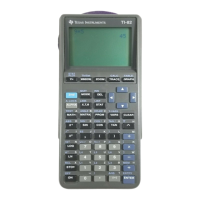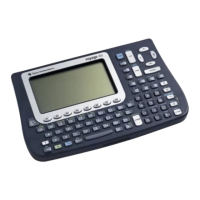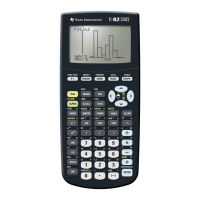TI-83 35
Two special exponents that can be produced on screen as raised exponents are the exponents
2 and 3. To enter the expression
2
5 you could use the standard approach of typing 5^2, or you
could instead type the 5 and then press the
2
x key. The
2
x key produces only the raised exponent
2 on the screen, not the x. Either way, the calculator produces the result of 25 when you press
ENTER. To produce a raised exponent 3, as in the expression
3
, first type 4 and then press the
MATH key. The calculator will display the MATH menu. Choice 3 on the MATH menu is the raised
exponent 3. Select it by pressing 3 (or by using the Down Arrow key to highlight the number 3
and pressing ENTER). The MATH menu will then disappear, and the calculator will display 4
3
.
Press ENTER to display the value of the expression, 64.
page 12
9 Square Root
See 3 Square Root.
page 14
10 Absolute Value
The absolute value of a number is the number's distance from zero on the number line. On the TI-
83 the absolute value is denoted abs. To produce the absolute value character, first press MATH.
Then use the Right Arrow key to highlight the NUM menu heading at the top of the screen. Choice
1 on the NUM menu is abs( . Either press ENTER, since choice 1 is already highlighted or press 1
to produce abs( on the screen. When we write the absolute value of −7 with pencil and paper,
we enclose the number within two vertical bars: 7− . On the calculator the absolute value of −7
is denoted abs(-7). As was the case with the square root, on the TI-83 the number or
expression (called the argument) whose absolute value is to be evaluated must be enclosed within
parentheses. The calculator again saves you a bit of typing by producing the open parenthesis
with the abs. To produce abs(-7)on your Home screen, first use the keystrokes described
above to produce abs( on screen. Then type in −7 (being sure to use the gray negative key), and
close the parentheses. Press ENTER to find the absolute value of −7, which is 7.
As was the case with square roots, the calculator takes the absolute value of the number or
expression enclosed in parentheses immediately to the right of the abs symbol. To evaluate
517 +− put the expression
inside the parentheses, since the addition is to be done
first: abs(–17+5). The result is 12, since 1212517 =−=+− . If you want to compute the
value of 517 +− , where the absolute value is to apply only to the number
17
, you must be
sure to put a close parenthesis after the
when you enter this expression into the calculator:
abs(-17)+5. The value of this expression is 22, since 22517517 =+=+− . If you forget
to type the close parenthesis, the calculator will assume that you wanted a close parenthesis
at the end of the expression. Thus, the calculator would interpret abs(-17+5 as being the
same as abs(–17+5), which is 12, as noted earlier. To evaluate 25 +− you would type in
abs(-5)+abs(2)and press ENTER to obtain the value 7.
To multiply the absolute value of −4 by the absolute value of 10, 104 ⋅− , you could use
the multiplication key to type in abs(-4)*abs(10), or you could just put the two absolute
values side-by-side with no symbol in between: abs(-4)abs(10). The calculator still knows

